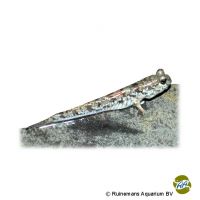Atlantic Mudskipper (Periophthalmus barbarus)
| Atlantic Mudskipper Periophthalmus barbarus | |
|---|---|
| Name | Atlantic Mudskipper |
| Name Lat. | Periophthalmus barbarus |
| Family | Mudskippers |
| Family lat. | Oxudercidae |
| Order | Gobies |
| Order lat. | Gobiiformes |
| Origin | West Africa |
| Habitat | Estuaries, mangrove swamps |
| Diet | Carnivore |
| pH | 7.5-8.5 |
| Behavior | Aggressive |
| Keeping | Pair, group |
| Care Level | Experts only |
| Reproduction | Cave spawner |
| Breeding | None reported |
| Life Span | N/A |
| Protection | No |
| Metric Units | |
| Size | 15-20 cm |
| Temperature | 25-30 °C |
| Hardness | 10-25 °dH |
| Aquarium | 250 l |
| US Units | |
| Size | 5.9"-7.9" |
| Temperature | 77-86 °F |
| Hardness | 178-445 ppm |
| Aquarium | 65 gal |
Distribution and habitat
African mudskippers are amphibious brackish water fishes widely distributed along the west coast of Africa, from Senegal to Angola. They live in the intertidal zone of river mouths (estuaries) and mangrove swamps, where they reside in the transition zone between water and land
Maintenance
They need a brackish water aquarium with at least 10 cm water depth and a land part that covers approx. ⅔ of the bottom surface, as they spend most of their time on land, with sufficient perching areas, such as stones and roots outside the water and a soft, graveable substrate of sand (coral sand) or fine gravel. Java fern (Microsorium pteropus) and living mangroves (e.g. Rhizophora stylosa or Rhizophora mangle) are suitable for planting, which also serves as a visual screen. The salinity of the brackish water should be about 15 ‰ (4-5 tablespoons of sea salt mixture to 10 l of water)
To ensure water quality, a filter and heater adapted to the water volume is required, as well as lighting for the species-appropriate day-night rhythm of the animals.
Diet
In the wild they feed on small insects, crustaceans and other mollusks. The food supply consists of live or frozen Tubifex, mosquito larvae, shrimps, mysis etc., also flies, house crickets or crickets are eaten with pleasure. After habituation, protein-rich dry food is usually also accepted, but should not be the main component of the diet. Feeding can be done in the water or on land
Only as much should be fed as is eaten immediately (in a maximum of 10 minutes). Regular and varied feeding promotes health and increases resistance
Behaviour and compatibility
They are very territorial fish, each animal occupies a territory that is consistently defended. Especially males behave extremely aggressive within the species and in too small tanks it can come to deadly fights. Therefore keeping a group is only possible in a much larger and richly structured (privacy) tank. It is recommended to keep them in a species tank. Only in a large aquaterrarium they can be socialized with other brackish water fish. They are predatory and fish that are too small are considered prey.
Sex dimorphism
The sexes are difficult to distinguish. With some experience, the sexes can be distinguished by their genital papilla, which is slender and pointed in the male and round and short in the female.
Reproduction and breeding
There are no known reports of successful breeding in the aquarium. In nature they dig burrows with two exits, where mating (internal fertilization) and brood care takes place
Important
During their stays on land, fish breathe atmospheric air through gills, since they do not have lungs. The gills contain special water-filled gill sacks, which are permeated by folded, well-perfused membranes and allow oxygen supply
Air and water temperature should be the same.
Their retractable eyes protrude, similar to frogs, giving them a 360° view. Below the eyes is a pocket of skin that stores fluid that prevents the eyes from drying out on land.
With their pectoral fins reinforced at the base like arms, which act like a kind of suction cup, they can move about hopping and even climb up smooth, steep surfaces. Accordingly, the aquarium should always be well covered to prevent escape.
The well-being of the fish should be checked regularly. Temperature should be checked daily, pH, hardness and nitrate levels at least every 14 days. Regular partial water changes are recommended, even if the contaminant level has not yet reached the upper limit. Sudden changes in water quality should be avoided. Newly introduced fish must be accustomed slowly to the water in the aquarium
Further literature can be found in your pet store.
References
Text: Werner Winter; Image: Ruinemans Aquarium B.V.
Source: BMELV (1998): Tierschutzgutachten - Haltung von Zierfischen (Süßwasser); RIEHL & BAENSCH (2004): Aquarien Atlas Bd. 1, Mergus Verlag; ENGELMANN (2005): Zootierhaltung - Tiere in menschlicher Obhut: Fische, Verlag Harri Deutsch
- Gemäß § 21 Abs. 5 Tierschutzgesetz idgF
